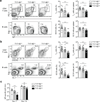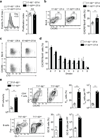The microRNA cluster miR-17∼92 promotes TFH cell differentiation and represses subset-inappropriate gene expression
- PMID: 23812098
- PMCID: PMC3720769
- DOI: 10.1038/ni.2642
The microRNA cluster miR-17∼92 promotes TFH cell differentiation and represses subset-inappropriate gene expression
Abstract
Follicular helper T cells (TFH cells) are the prototypic helper T cell subset specialized to enable B cells to form germinal centers (GCs) and produce high-affinity antibodies. We found that expression of microRNAs (miRNAs) by T cells was essential for TFH cell differentiation. More specifically, we show that after immunization of mice with protein, the miRNA cluster miR-17∼92 was critical for robust differentiation and function of TFH cells in a cell-intrinsic manner that occurred regardless of changes in proliferation. In a viral infection model, miR-17∼92 restrained the expression of genes 'inappropriate' to the TFH cell subset, including the direct miR-17∼92 target Rora. Removal of one Rora allele partially 'rescued' the inappropriate gene signature in miR-17∼92-deficient TFH cells. Our results identify the miR-17∼92 cluster as a critical regulator of T cell-dependent antibody responses, TFH cell differentiation and the fidelity of the TFH cell gene-expression program.
Figures






Comment in
-
Control of T(FH) differentiation by a microRNA cluster.Nat Immunol. 2013 Aug;14(8):770-1. doi: 10.1038/ni.2671. Nat Immunol. 2013. PMID: 23867925 No abstract available.
References
-
- Crotty S. Follicular helper CD4 T cells (TFH) Annu. Rev. Immunol. 2011;29:621–663. - PubMed
-
- Vinuesa CG, Sanz I, Cook MC. Dysregulation of germinal centres in autoimmune disease. Nat. Rev. Immunol. 2009;9:845–857. - PubMed
-
- Yu D, et al. The transcriptional repressor Bcl-6 directs T follicular helper cell lineage commitment. Immunity. 2009;31:457–468. - PubMed
Publication types
MeSH terms
Substances
Associated data
- Actions
Grants and funding
LinkOut - more resources
Full Text Sources
Other Literature Sources
Molecular Biology Databases

